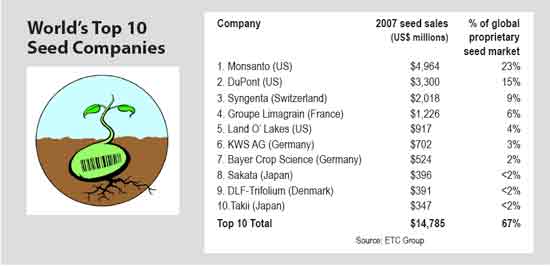Frank Morton, an organic seed breeder from Philomath, Oregon, explains the current structure of the global commercial seed industry, as part of our ongoing series, Seeds of Life.
(see related: Animated Charts Showing the Seed Industry Structure from Phil Howard, Assistant Professor, Michigan State University.)
On the surface, understanding the organizational structure of the seed industry may seem a pursuit into the arcane and wonkish world of academics and private seed breeders. This is certainly not the case so much more is at stake!

According to the ETC Group’s, November 2008 report, Who Owns Nature (PDF), 67% of the commercial seed industry is controlled by just 10 global corporations. By contrast, prior to 1950, most seeds where freely available for use by farmers, and universities, whose seed breeding research programs were held in the public domain. The rise of consolidation in the seed industry parallels the rise of biotechnology in food crops. Since 1996, when only 37% of the commercial seed business was controlled by private interests, as of 2007, that number has skyrocketed to 82%.
In a recent New York Times article, Rapid Rise in Seed Prices Draws U.S. Scrutiny, the price of corn seed, the most dominant seed crop, has risen 132% since 2001. Soybeans, another major seed crop, rose 108% over this same period of time. The U.S. Department of Justice is currently investigating the seed industry for possible antitrust violations.
Check out the links below, for those interested in the Frank Morton series:
- Seeds of Life: David Vs. Goliath (published: 12-2009)
- Seeds of Life: Beta Vulgaris (12-2009)
- Seeds of Life: The Organic Seed Breeder (3-2010)
- Seeds Of Life: Hybrids and the Emergence of Seed Monopolies (3-2010)
- Seeds Of Life: Open Pollination (6-2010)
- Seeds of Life: Consolidation in the Seed Industry(7-2010)
Most of the videos featured on Cooking Up a Story were produced, filmed, and edited by Rebecca Gerendasy. Fred Gerendasy contributed as a writer to many of the posts and occasionally as the interviewer. Visit Rebecca Gerendasy Clay – Art and Fred Gerendasy Photography to see their current work.
